Elk hunting is one of the most sought after adventures in various parts of the world, especially in America. Elks are interesting animals but extremely challenging to hunt due to their elusive nature. Whether you are a newbie or an expert, there are certain things about this big animal that you must know.
Though elusive, wapitis have a set pattern of everything which leaves hunters surprised and impressed. From their habitat to eating patterns, their bedding to behavioral characteristics, everything tells so much about elks. These patterns help hunters to track down the wapitis that they have been long trailing after.
To provide you with a deeper insight into everything related to these huge animals, we have compiled a detailed guide. You will find information on elks alongside answers to some common questions about wapitis.
- What Is Elk?
- How To Go Elk Hunting – Elk Hunting Tips And Tricks
- How To Get In Shape For Elk Hunting?
- Best Hunting Times For Elk
- How To Hunt Elk Post Rut?
- How To Hunt Elk On Public Land?
- Elk Eating Habits, Characteristics and Behavior
- Subspecies of Elk
- Roosevelt Elk vs Rocky Mountain Elk
- Conclusion
- Frequently Asked Questions
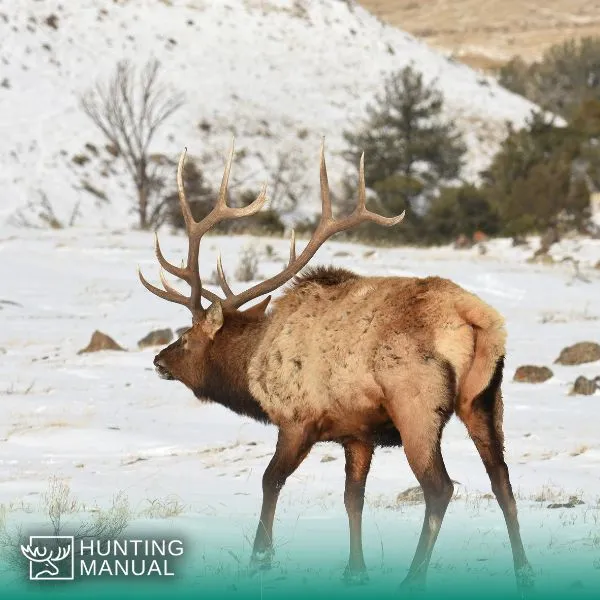
What Is Elk?
The elk belongs to the deer family and is one of the largest species in the entire family. Many people confuse elk with a deer however, both the animals are totally different. Despite belonging to the same family, both have a significant difference in appearance, especially in size – elks are a lot bigger than deer. Similarly, there are significant differences between elk and moose.
Hunters distinguish between male and female elk on the basis of their antlers. Antlers are basically the extension of a skull and are present on the head of members belonging to the Cervidae (deer) family. Male elks, also known as bulls, have antlers that are likely to grow incredibly up to 4 feet above the animal’s head. On the other hand, a female elk, also called a cow, lacks antlers.
How To Go Elk Hunting – Elk Hunting Tips And Tricks
You can’t go elk hunting unless you are skilled enough and have all the important gear. So, make sure to pack the following things with you before you go out to bag yourself a wapiti.
- Hunting license
- First aid
- Strong rope (at least 20’ long)
- Watch, compass and GPS navigator
- Food and water supplies
- Knives, sharpener and meat bags
- Glassing equipment (hunting rangefinder/binocular/spotting scope)
- Weapons with ammunition
- Protective gloves and proper clothes as per weather and season
- Flashlights with extra batteries
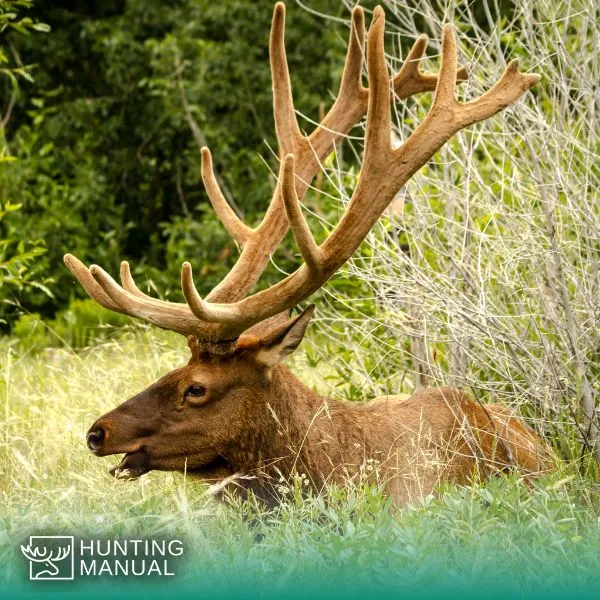
No wonder elk hunting is an overwhelming experience but only if you have all the important knowledge for it. Whether you are new to this adventure or an experienced hunter, it is important to learn about their living patterns for a hassle free hunt.
Where Do Elk Live?
Currently, the elks are native to the western side of North America mostly in the mountainous region. Some common places in North America where you can find a plethora of elks include Yellowstone National Park and Wyoming’s National Elk Refuge. Previously, these animals were found almost all across the North American region but due to excessive hunting, these were provoked to take refuge in isolated areas of the region.
Elk Habitat
Elks have a wide distribution of habitats and thrive in various of them such as eastern deciduous forests, and coniferous rain forests that run along the Pacific coast. Moreover, wapitis also live in aspen parklands, rocky mountains, prairies, swampy California valleys, and sagebrush flats. These big animals shun areas like boreal forests, deserts, and tundra.
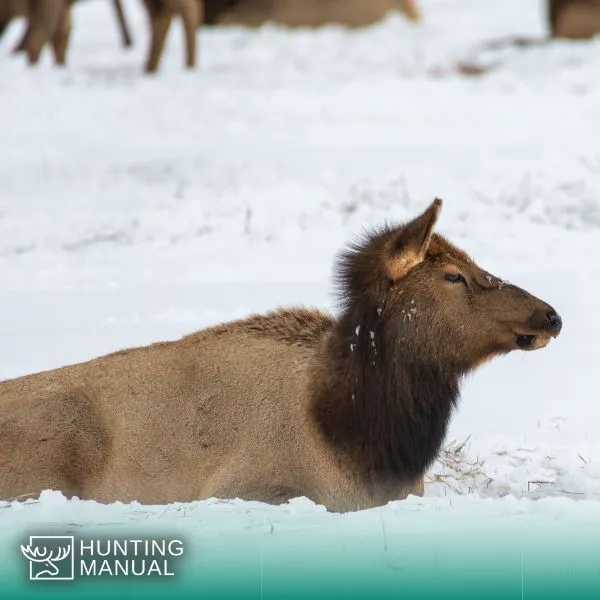
Elk Bedding
Usually, these creatures like to bed down in groups so that they are less prone to danger which comes mostly in a form of predators. When the weather is humid, elks find their day bedding areas on north facing slopes. Whereas, for the nighttime, they prefer south facing slopes to bed down.
Contrarily, during colder weather, wapitis like to bed on south facing slopes in the daytime. On the other hand, a night bed would be someone on the north facing slopes. They choose the slopes based on the right temperature that keeps them cozy in different seasons,
Remember: The bedding areas are mostly near timber clumps except for the night bedding in warmer weather.
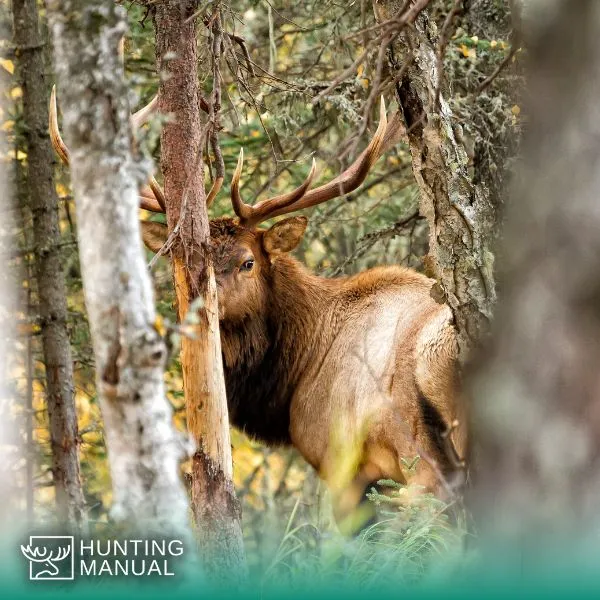
How To Get In Shape For Elk Hunting?
Regardless of the place you choose for hunting a wapiti, you would require immense stamina, core strength, and physical stability. It is crucial to train your body and get in shape before you go elk hunting. Make sure to start preparing yourself at least 2 to 3 months beforehand. This will ensure that you have gained enough muscular power to deal with the tough challenges encountered during a hunt.
There are a few common exercises that most hunters perform in order to get into shape. These include:
- Running: Cardiovascular endurance must be your foremost priority since it either makes you or breaks you during a hunt. From rugged terrains to elevation gains, your lungs and heart must be strong enough to withstand the rigors of hunting.
Start running 1-3 miles and increase up to 5-8 miles with time. The best time to run will be in the morning and for at least three to five days a week.
- Weighted Step-Ups: You would move up or downhill loaded with stuff and even an entire elk if you get one. Therefore, this one would be the best exercise to train your legs for movement with load.
Make a target of completing at least 600 to 800 weighted step-ups in total (in 3 months). Do 20-30 reps within 60 seconds and take a rest for 30 seconds. Continue this for a total of 30 minutes and make sure to do this workout thrice a week.
- Ruck Marching: This workout teaches you how and where to load your stuff during the hunt. This exercise is practiced mostly by military men since they carry huge packs with them.
Begin practicing this exercise by packing lightweight around 30 to 40 pounds and taking a brisk walk around for 15 to 20 minutes. The next day, carry heavyweight, load it on yourself in a comfortable position and walk a good 5 to 8 miles. You can start with lesser miles and increase with time accordingly.
It is also recommended to practice rucking with some hikes and running. You can perform this exercise twice or thrice a week.
Best Hunting Times For Elk
As the majority of the animals, elks are also highly active throughout the morning and evening hours. Therefore, the best time to hunt down elk would be early morning and dusk when these creatures venture out for food and defecation.
As for the moon phase, the best time would be the first half of the month. During this time there is little to no moon and that is when elks are out a lot more as compared to the second half of the month. These animals are likely to stay outside more in the morning hours.
How To Hunt Elk Post Rut?
It could be daunting to find bulls post-rut season since they are most likely to be in the recovery phase. Right after the rut season ends, bulls and cows segregate and take covers in separate areas from each other.
One good thing about elk post-rut is that they form predictable living and travel patterns. They are most probable to take cover near the ample food and water source. This creates an exciting opportunity for the hunters to glass the bulls. Additionally, the following tips will help you efficiently bring an elk out post-rut:
- Look for bulls at the south facing slopes
- Keep an eye on places with heavy vegetation
- E scout for bedding areas
- Try loud bugles
When Do Elk Rut?
The rutting season is likely to start from August and lasts till mid of October. The rut is another name for the breeding season for an elk during which the bulls call out the cows for mating. Throughout the rut season, bulls are mostly aggressive.
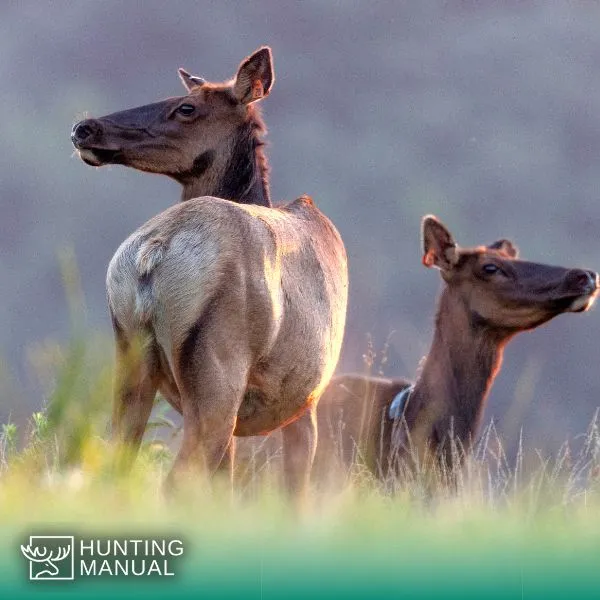
How To Hunt Elk On Public Land?
You may be a professional and master of your craft but do you have the expert tips to hunt on public land? Here are top tricks for you that can get you one step closer to bagging a public land wapiti.
- Use your optics to find elk from a high vantage point
- Stay confident and aggressive
- Bugle louder than the entire bull herd
- Stay safe in hard to reach areas
- Keep elk sanctuaries in mind
- Set an ambush
- Always be prepared for the shot
Elk Eating Habits, Characteristics and Behaviors
Understanding wapiti’s characteristics and behavior are crucial when you plan to hunt it down.
Wapitis are herbivorous which means they only feed upon vegetation such as grass, stems, flowers, mushrooms, etc. However, they keep changing their diet according to the weather to provide their body with the right nutrients. For example, in summers, elk would munch on grasses, twigs, tree barks, forbs, and shrubs. Whereas, in winters they would switch to eating woody growth or cured grass.
Out of the numerous choices, violets, mushrooms, clover, dandelions, aster, and hawkweed remain elk’s favorite food.
Range of Elk
Range of elk is usually referred to as the animals area coverage during lifetime. Elk range varies based on subspecies but normally, elk travels from 1500 acres to 10,000 acres.
Let’s not confuse range with rangefinder which provides distance from point A to point B and angle of elevation. Rangefinders provide estimated range to hunters who use data to hunt big game with various gear i.e. bow, rifle, etc. While on hunt, these expensive gear need to be protected from shock and weather, thus rangefinders are covered with best rangefinder cases.
Are Elk Nocturnal?
Yes, elks are nocturnal meaning that they are highly active during the late night hours and will hide or become less active during the daytime. For a bull, the ‘day’ will begin when the sun is about to set and late afternoon hours begin.
The foremost reason for their nocturnality is the fear of predators who are out in search of their hunt. Therefore, to stay safe from being hunted down, these animals decide to stay under cover during the daytime when most of the hunters are out.
Do Elk Bugle Year Round?
Bugle is a screaming noise that male elks make to seek the cows for mating. The sound starts with a low pitch which soon transitions into something that can only be called a loud wailing scream.
With the rut season comes the higher number of bugles made by the bulls. It also warns all the other male elks in the nearby areas about the dominance. Elks commonly produce bugle heralds between dawn to dusk in the Western United States.
Do Elk Travel In Herds?
Just like deer and other members of this family, elks are extremely social as well. Therefore, they would love to travel with a large number of fellow elks. A group of elk is called a herd which is pretty large, comprising as many as 200 members. Some herds are even larger and have more than 400 elks in them. The herd is segregated into two groups based on gender i.e., bulls form one group and cows form another.
Subspecies of Elk
The accurate number of elk subspecies is still unknown. However, according to our research, the following are the most commonly known ones. These include Eastern Elk, Roosevelt Elk, American AKA Rocky Mountain Elk, Manitoban Elk, Tule Elk, Merriam Elk, and Irish Elk.
Some of the aforementioned subspecies have unfortunately become extinct. Whereas the others live in isolated places, most of them belong to the North American regions. Out of them, only three subspecies i.e., Roosevelt Elk, Rocky Mountain Elk, and Tule Elk are huntable.
- Eastern Elk
This is an extinct subspecies and on September 1, 1877, in Pennsylvania, hunters shot its last living member. These wapitis were the inhabitant of Easter and Northen US as well as Southern Canada.
- Roosevelt Elk
Roosevelt elk are the largest surviving elk subspecies that live in Washington and Oregon. However, some of its members were also seen residing in British Columbia and Northern California.
The terrain of the places where these species live is usually very wet and rugged. This is because most of them live in the rainforests of Oregon. A mature Roosevelt elk weighs nearly 1,000 pounds whereas its adult cow weighs up to 600 pounds.
- Rocky Mountain Elk
Rocky Mountain Wapitis or American Elks are the most widely spread subspecies. You can find the largest herd of these animals in Colorado comprising a massive number of elks i.e., 300,000 elks in one herd. Their males are relatively less heavy as compared to the Roosevelt and weigh 800 pounds or more. Whereas, their cows typically tip the scale between 450 to 500 pounds.
- Mantiboan Elk
As referred by the name, these animals are found mostly in Manitoba as well as Saskatchewan. It is believed that some members from this subspecies crossed the border historically and now live in the Great Lakes States too. They are larger in size with smaller antlers as compared to the American elk. In the 1900s, Manitobans were on the verge of extinction but were fortunately saved.
- Tule Elk
You can only find these animals for a hunt in various parts of Central California. The weather in which Tules would thrive is the Mediterranean climate and a plethora of vegetation subsequent to its native residing area. Tule elks are significantly smaller in size as compared to the other subspecies. Rightly so, its bull typically weighs nearly 600 pounds or more whereas, the female weight ranges between 300 to 350 pounds.
- Merriam Elk
Used to live in some isolated parts of the Southwest US such as New Mexico and Arizona, this is another extinct subspecies of elk.
- Irish Elk
The Irish subspecies of wapitis collapsed nearly 8,000 years ago. Almost 400,000 years ago, these animals used to roam in parts of Asia and Europe. The other name for these animals is ‘giant deer’ because of their extremely large body and even bigger antlers. Irish elk are also known as the largest deer species that ever lived on this planet.
Roosevelt Elk Vs Rocky Mountain Elk
Roosevelts measure the largest among all the four surviving subspecies in North America. However, they have bigger bodies but relatively small antlers as compared to the Rocky Mountain elk. Roosevelts reside in the coastal ranges, the rocky mountain elks live in the mountain ranges.
The Roosevelt Elk range is quite brief throughout the year i.e., between 1,500 to 4,000 acres. This is because they live in places with less harsh weather conditions and plentiful food sources. On the other hand, the Rocky Mountain Elks range is pretty large and varies from 2,500 to 10,000. This usually includes distinct wintering and summering regions.
Roosevelt wapitis have a darker appearance than the Rocky Mountains and are much more challenging to hunt. The main reason is that they bugle comparatively less than the American Elks. That said, hunters will have to encounter some challenges to find them.
How Big Are Elks?
Wapitis share physical similarities with deer, caribou, and moose. These are larger than deer in size but smaller than moose. An adult bull (male) reaches its maximum size at the age of 7 years. At this age, it is considered a fully grown elk. The bull elk weight ranges from 700 to 1100 pounds and stands tall at an average height of 5 feet at the shoulders.
An adult/ fully grown female cow elk size is lesser than the male and weighs between 500 to 600 pounds. These average 4.5 feet at the shoulders in terms of height.
Weight of Largest Elk Ever
The largest elk species even today is from the extinct subspecies i.e., the Irish Elk. One of its male bulls measured around 1500 pounds; this size is similar to an Alaskan moose which is pretty bigger than an elk. It also had the world’s largest antlers ever up to 12 feet across and weighed as much as 90 pounds.
Conclusion
Elk hunting can bring immense joy to the faces of hunters but only when it is done right. The main reason why it puts novice hunters down is the challenges that come along. Most of the new hunters are unaware of the patterns that these elusive creatures have set and hence, fail to bag them.
So, to take a bull or cow successfully, you must understand the major things and put all your effort into it. Do your research, take time to understand their nature and patterns, and most importantly, train yourself extensively. In the end, all of it will surely pay off and you will finally notch that elk tag.
To read more about elk hunting seasons, zones, regulations, license information and harvest stats visit California Wildlife department.
Frequently Asked Questions (FAQ’s)
Elk love migrating in herds and they do it usually between the summer and winter seasons. These animals are strong and have immense stamina hence, can easily travel from 30 miles to 90 miles.
Four subspecies of elks are found in North America. These include Roosevelt elk, Rocky Mountain elk, Tule elk, and Manitoba elk.
The lifetime of a wapiti varies depending on the geography. However, the average lifespan of these animals in the wild is somewhere between 10 years to 13 years.
Yes, you can hunt wapitis in Texas, Virginia, Michigan, and Pennsylvania. However, you must have a valid elk hunting license for the respective state.
Several factors contribute to the overall cost of elk hunting. For example, your hunting style, area, accommodations, weapons used, the caliber of bulls, the supplies you will carry along, etc. That said, based on the aforementioned factors, hunting an elk can cost you a minimum of $2000 or more than $10,000.

Leave a Reply